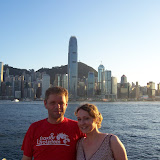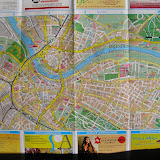 what I am talking about is how to optimize the trips using the public transport. At the beginning the public transport system was a huge blurred mystery to us, and how to get where and by what at the fastest and cheapest option, was a cause of long and time wasting research. The public transport system here is very efficient, frequent and cheap, and offers everything from minibuses and buses to the MTR (Mass Transit Railway). If you know your destination, it is quite easy to figure out which MTR line will take you closest to that. The system of buses though is a bit more complicated as you are new in town and don't know the whereabouts of the destinations, displayed on the buses,
what I am talking about is how to optimize the trips using the public transport. At the beginning the public transport system was a huge blurred mystery to us, and how to get where and by what at the fastest and cheapest option, was a cause of long and time wasting research. The public transport system here is very efficient, frequent and cheap, and offers everything from minibuses and buses to the MTR (Mass Transit Railway). If you know your destination, it is quite easy to figure out which MTR line will take you closest to that. The system of buses though is a bit more complicated as you are new in town and don't know the whereabouts of the destinations, displayed on the buses, and so you can't be sure that this or that bus could be any good. Anybody who has tried to move to a new city will recognize the difficulties in the beginning. It is like starting a game of Civilization on the computer; at the beginning only what is just around you is visible, and only by moving around to explore this also becomes visible and you start to orientate by "drawing a map in your head" so to speak, and by time more and more of the city's geography will be added to this mind map, as you move around and get to know where the places of interest is located. On that way you also find out which buses and minibuses will take you where and when. Having sorted some key destinations, the MTR lines and useful buses, you have gathered a sort of major overview and can start moving around without a map.
and so you can't be sure that this or that bus could be any good. Anybody who has tried to move to a new city will recognize the difficulties in the beginning. It is like starting a game of Civilization on the computer; at the beginning only what is just around you is visible, and only by moving around to explore this also becomes visible and you start to orientate by "drawing a map in your head" so to speak, and by time more and more of the city's geography will be added to this mind map, as you move around and get to know where the places of interest is located. On that way you also find out which buses and minibuses will take you where and when. Having sorted some key destinations, the MTR lines and useful buses, you have gathered a sort of major overview and can start moving around without a map.
As I've had plenty of time between my duties as a house keeper, a blogger, doing job inquiries and bla bla bla, so I was always the chosen one to take visitors out in Hong Kong and show them around, and so -of course- we used the public transport to get to all wanted sights, and now
 I'm able to tell which bus to which MTR station and where to get off and maybe again change to bus, and so on. And finally we come to the subject; how to optimize your trip. Using public transport in a big city also means that you might have to change from bus to MTR and even to a ferry to get to your final destination. This means also that you have to walk a bit and wait for the next connection.
I'm able to tell which bus to which MTR station and where to get off and maybe again change to bus, and so on. And finally we come to the subject; how to optimize your trip. Using public transport in a big city also means that you might have to change from bus to MTR and even to a ferry to get to your final destination. This means also that you have to walk a bit and wait for the next connection.Even in Dresden -though it is way smaller than Hong Kong- I had to change the tram once to get from my house to my work. Normally I went by bike, but every now and then I took the tram, and there I used to get into the last wagon of the tram as I changed the one time at Strassburger Platz, and I did it because as the tram arrived at Schandauer Strasse, I just had to get out of the last door of the tram, and then I could walk just straight to the entrance of the Medienkulturzentrum.



In Hong Kong at the beginning we always spend lot of time walking around the huge MTR stations to find the exit suitable for our destination,
 as they have lots of exits. Even when you get out of the train you might have to change to another and therefor walk through tunnel to get to the next platform, or you simply want to get out and need to find the escalator or the staircase, again time and power is needed. As the MTR always has the same lenght as the platform, it always stops at the same place, so by the time I've figured out excately where to go, which door to use to the compartment and which to get out of
as they have lots of exits. Even when you get out of the train you might have to change to another and therefor walk through tunnel to get to the next platform, or you simply want to get out and need to find the escalator or the staircase, again time and power is needed. As the MTR always has the same lenght as the platform, it always stops at the same place, so by the time I've figured out excately where to go, which door to use to the compartment and which to get out of  again to be just at the escalator or the tunnel to the next platform, and not only that, no also which escalator is nearest to the exit I finally need to get to the wanted location. It might seem silly to take a such positivistic approach to optimize the daily transport, but at the bottom linen; in a city this big, it is really a matter of time, and as you want to get somewhere to do something you need to take such measures or you will spend more time traveling, than you can spend being there.
again to be just at the escalator or the tunnel to the next platform, and not only that, no also which escalator is nearest to the exit I finally need to get to the wanted location. It might seem silly to take a such positivistic approach to optimize the daily transport, but at the bottom linen; in a city this big, it is really a matter of time, and as you want to get somewhere to do something you need to take such measures or you will spend more time traveling, than you can spend being there.





















No comments:
Post a Comment